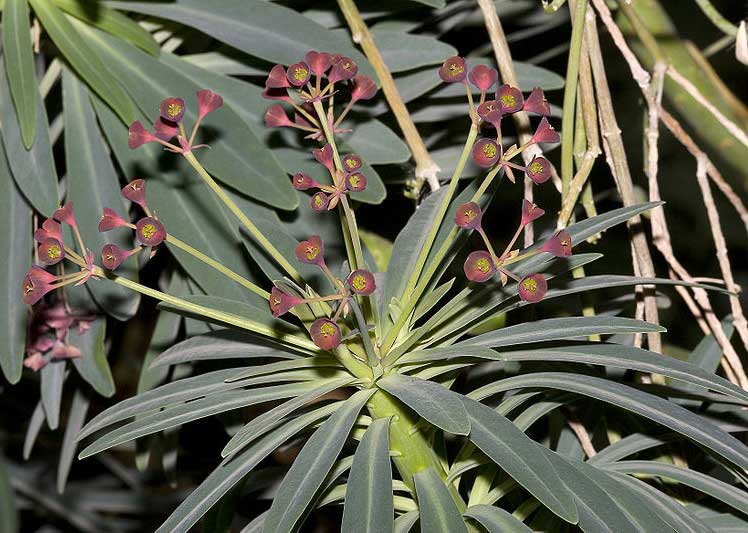
Euphorbia atropurpurea, (*)
Classification System: APG IV
Superregnum: Eukaryota
Regnum: Plantae
Cladus: Angiosperms
Cladus: Eudicots
Cladus: Core eudicots
Cladus: Rosids
Cladus: Eurosids I
Ordo: Malpighiales
Familia: Euphorbiaceae
Subfamilia: Euphorbioideae
Tribus: Euphorbieae
Subtribus: Euphorbiinae
Genus: Euphorbia
Subgenus: E. subg. Euphorbia
Sectio: E. sect. Brasilienses
Species: Euphorbia attastoma
Varieties: E. a. var. attastoma – E. a. var. xanthochlora
Name
Euphorbia attastoma Rizzini 1989
Distribution
Native distribution areas:
Continental: Southern America
Regional: Brazil
Brazil (Minas Gerais)
References: Brummitt, R.K. 2001. TDWG – World Geographical Scheme for Recording Plant Distributions, 2nd Edition
References
Primary references
Rizzini, C.T., 1989, Revista Brasileira de Biologia 49:987.
Links
Govaerts, R. et al. 2020. Euphorbia attastoma in World Checklist of Selected Plant Families. The Board of Trustees of the Royal Botanic Gardens, Kew. Published on the internet. Accessed: 2020 Jun 20. Reference page.
International Plant Names Index. 2020. Euphorbia attastoma. Published online. Accessed: Jun 20 2020.
Govaerts, R. et al. 2020. Euphorbia attastoma in Kew Science Plants of the World online. The Board of Trustees of the Royal Botanic Gardens, Kew. Published on the internet. Accessed: 2020 Jun 20. Reference page.
Tropicos.org 2020. Euphorbia attastoma. Missouri Botanical Garden. Published on the internet. Accessed: 2020 Jun 20.
USDA, ARS, Germplasm Resources Information Network. Euphorbia attastoma in the Germplasm Resources Information Network (GRIN), U.S. Department of Agriculture Agricultural Research Service. Accessed: 08-Apr-12.
Vernacular names
Euphorbia atropurpurea, called tabaiba majorera or tabaiba roja in Spanish, is a shrub in the family Euphorbiaceae native to Tenerife in the Canary Islands. It can reach 2 metres in height, and grows in ravines, and on slopes and terraces.
The plant grows best in humid conditions in mid to low altitudes (300-1,200 m) on the south and west parts of the island. It is plentiful in the towns of Teno, Santiago del Teide, and the slope of Güímar.
Detail of the floral bracts
The shrub can reach over 2 m with succulent brown stems and branches without spines.[1]: 210 It has large bluish green leaves, which form a rosette at the end of the branches. The plant flowers from winter to spring (December to May). The flowers have dark red bracts greater than 1 cm in size. These bracts lend the plant its name, atropurpurea (from the Latin ater or "black", and purple). It should not be confused with E. bravoana, which is endemic to the nearby island of La Gomera and also has purple-red bracts. The fruit is a red capsule with three dark brown seeds.
Like other plants in the genus Euphorbia, it produces a toxic white latex if cut.
E. atropurpurea is used as an ornamental plant in gardens for its eye-catching appearance and flowers. It requires little care, but requires sunlight and a certain amount of environmental humidity. It generally spreads by seeds, or more rarely by simply branching out.
In the area of Masca, in Tenerife, hybrids between E. atropurpurea and Euphorbia regis-jubae occur, which the Swedish botanist Eric Ragnor Sventenius named Euphorbia navae in honour of Alonso de Nava y Grimón, founder of the Botanical Garden of La Orotava.
References
Bramwell, D.; Bramwell, Z. (2001). Wild flowers of the Canary Islands. Madrid, Spain: Editorial Rueda. ISBN 978-84-7207-129-2.
Retrieved from "http://en.wikipedia.org/"
All text is available under the terms of the GNU Free Documentation License

